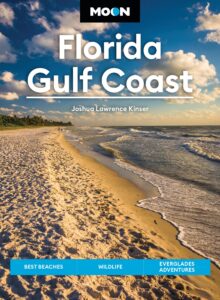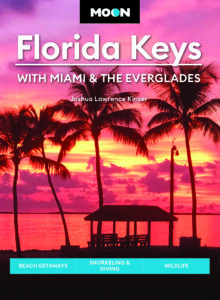North Miami Beach and Miami Beach
North Miami Beach
Between Fort Lauderdale and Miami Beach, Hwy-A1A runs along the shore, first as Ocean Drive and later as Collins Avenue, while US-1 runs inland parallel to (and sometimes as) the old Dixie Highway. There’s nothing here to compare with the attractions farther south, but the town of North Miami Beach does have one oddity: the Ancient Spanish Monastery (16711 W. Dixie Hwy., 305/945-1461, 10am-4:30pm Mon.-Sat. , 11am-4:30pm Sun., $10), a 12th-century monastery bought in the 1920s by William Randolph Hearst, who had it dismantled and shipped to the United States for his Hearst Castle complex in California. However, after U.S. Customs confiscated the stones, and Hearst lost his fortune in the Great Depression, the monastery was finally rebuilt here in Florida—as an Episcopal church.
On the coast, Hwy-A1A runs past a number of indistinct beach towns before hitting Bal Harbour, home to one of Miami’s biggest and best shopping malls, and one of its biggest beaches, Haulover Beach. Besides having a café, lots of tennis courts, and gorgeous sands, Haulover Beach is also famous for attracting the clothing-optional crowd.
From Haulover Beach south to Miami Beach, Collins Avenue (Hwy-A1A) used to be known as “Millionaire’s Row” for all the huge estates here. Now the road is lined with towering concrete condos and hotels, including the landmark Morris Lapidus-designed complex of the Fontainebleau (4441 Collins Ave., 305/538-2000, $249 and up). It’s been the setting for several movies: Jerry Lewis filmed The Bellboy here in 1959; Sean Connery checked in as James Bond, most famously in the 1964 film Goldfinger; and Al Pacino hung out by the pool in the quintessential 1980s Miami movie, Scarface.
Miami Beach
Covering a broad island separating downtown Miami from the open Atlantic Ocean, Miami Beach (pop. 91,718) has long been a mecca for fans of 1930s art deco architecture and design. More recently, it’s also become one of the world’s most fashionable and bacchanalian beach resorts, with A-List celebrity entertainers and artists preening around the deluxe hotels and high-style nightclubs and restaurants that line the broad white sands of South Beach, the relatively small corner of Miami Beach that gets 99 percent of the press and tourist attention. Here, along beachfront Ocean Drive and busier Collins Avenue (Hwy-A1A) a block inland, you’ll find dozens of glorious art deco hotels, many lighted with elegant neon signs. Guided walking tours (daily, $25) of the district leave from the Art Deco Welcome Center (1001 Ocean Dr., 305/672-2014, daily), which also rents iPod-based self-guided tours and sells guidebooks, posters, postcards, and anything else you can think of that has to do with the art deco era.
No matter how intoxicating the architecture, beach life, and nightlife along South Beach are, while you’re here, be sure to set aside an hour or two to explore the fascinating collection of pop culture artifacts on display two blocks inland at the Wolfsonian (1001 Washington Ave., 305/531-1001, Thurs.-Tues., $10 adults). One of the odder highbrow museums you’ll find, the Wolfsonian (officially the Mitchell Wolfson Jr. Collection of Decorative and Propaganda Arts) fills a retrofitted 1920s building with seven floors of furniture, sculpture, architectural models, posters, and much more, almost all dating from the “modern era,” roughly 1850 to 1950. Two areas of excellence are drawings and murals created under the New Deal auspices of the WPA, and similar agitprop artifacts created in Weimar, Germany. Only a small portion of the extensive collection is on display at any one time, and most of the floor space is given over to changing exhibitions—on anything from World’s Fairs to Florida tourism to how children’s books were used to indoctrinate future soldiers—but it’s a thought-provoking and surprisingly fun place, with an unexpressed but overriding theme of how art can counterbalance, or at least respond to, the demands of industrial society.
Where to Eat and Stay in Miami Beach
Not surprisingly, there are scores of cafés and restaurants in and around Miami Beach. Just two blocks west of the beach, the 11th Street Diner (305/534-6373) on 11th Street and Washington Avenue is a 1948 Paramount prefab diner, plunked down in 1992 and open 24 hours ever since.
For an unforgettably hedonistic experience, check into one of South Beach’s great old art deco hotels, or at least saunter through the lobby and stop for a drink. Dozens of these 1930s divas stand out along Ocean Drive and Collins Avenue. The Delano South Beach (1685 Collins Ave., 305/672-2000, $249 and up) is a high-style Shrager-Starck symphony in white. In other cases, alas, the wonderful architecture doesn’t always mask the elderly bones, nor is the 24-hour hubbub that surrounds them especially conducive to a good night’s sleep. Ocean Drive is undrivable on weekend nights, since so many cars cruise up and down it, stereos blasting.
Stylish though it is, South Beach is not frequented by many locals, who instead tend to spend time on Lincoln Road, a half mile north of South Beach. The Mediterranean Revival-style commercial district along Lincoln Road, developed in the 1920s by promoter Carl Fisher, was the original main drag of Miami Beach; it has been pedestrianized and nicely landscaped and is now packed with dozens of lively sidewalk cafés. Designer tacos can be appreciated at HuaHua’s Taqueria (1211 Lincoln Rd., 305/534-8226).
Related Travel Map
















